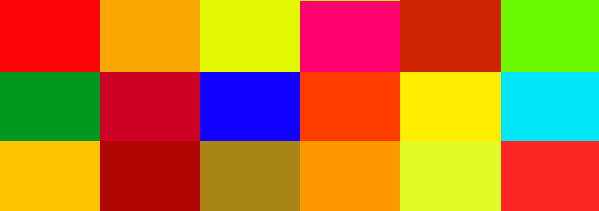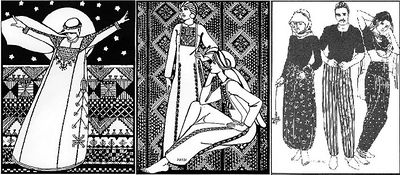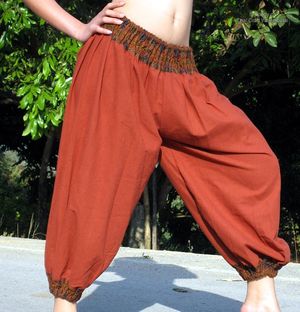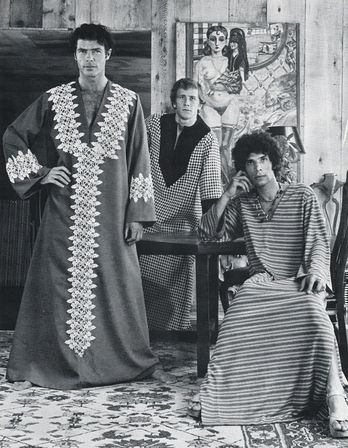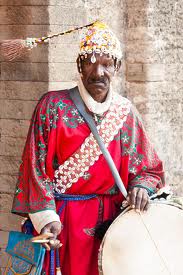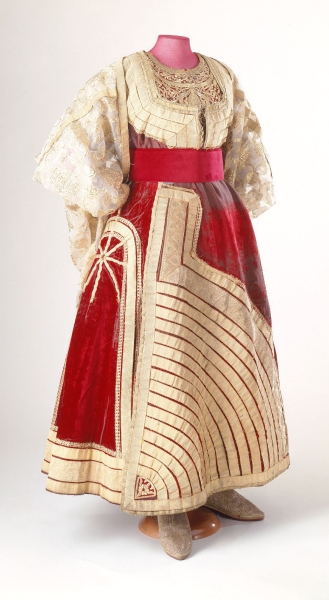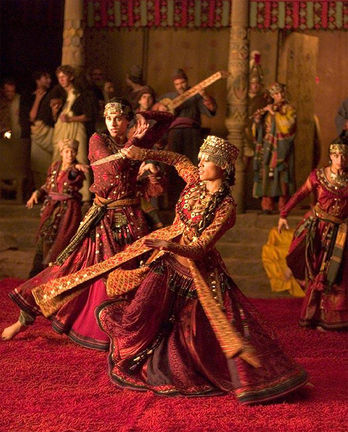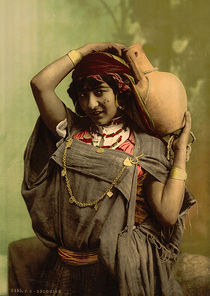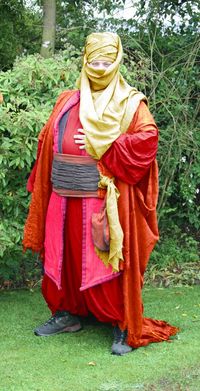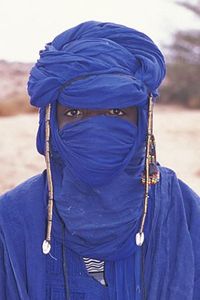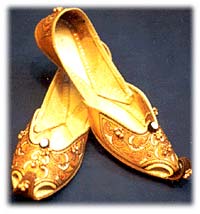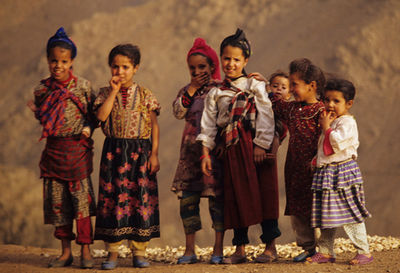The Brass Coast costumes
m (→The Clothes) |
No edit summary |
||
| Line 4: | Line 4: | ||
== Overview == | == Overview == | ||
The Brass Coast offers a chance to create some flamboyant and really expressive costumes. The Freeborn attitude to life is all about individuality, passion and luxury, and this | The Brass Coast offers a chance to create some flamboyant and really expressive costumes. The Freeborn attitude to life is all about individuality, passion and luxury, and many Freeborn express this through their dress. Success is measured in wealth, and what better way to demonstrate that wealth than by wearing it openly? The Freeborn look is usually one of bright colours, silks, jewels and sumptuousness. Individual style is highly valued and the mundane and common scorned. The Brass Coast lives for dance and music, and the clothing worn there often reflects this. With the flame being the central symbol for the Freeborn, it’s no surprise to find that their clothing is made in brightly coloured layers to convey the impression of the fire within. | ||
“Life is short — let it never be dull!” | |||
== | ==10 Quick Tips for Costume on The Brass Coast== | ||
The | |||
* Generally, an outfit is likely to consist of trousers, top, a robe of some sort and a head dress. | |||
* A great way to achieve the richness and the movement in Freeborn style is through costume in multiple layers - working from heavier warm layers as a base and floating fabrics as a top layer. | |||
* To cope with the British climate, fleeces are ideal as linings for more flamboyant fabrics, and light wools can be dressed with metallic brocades or embroidery. Multiple layers of silks are also surprisingly effective at keeping out the cold. | |||
* Bright colours layered together can give a wonderful range of shades which alter as the wearer moves - or [http://en.wikipedia.org/wiki/Shot_silk ‘shot’] fabrics, also called ‘changeant’ can look incredible in flowing robes, scarves and skirts. | |||
* Whilst the style and clothing inspirations are Moorish and North African, the colours, beading and embroidery of sari and other fabrics widely available in Asian clothing shops across the UK so these can be a great source of materials. Shalwar Kameez can be a useful base layer. | |||
* Both charity shops and on-line stores can be good sources of Arabic and North African loose tunics and trousers - often in white cotton which will dye well in bright colours. | |||
* To really keep the flowing feel of Freeborn style, try avoiding heavy belts and instead secure layers of clothing with scarves; hanging pouches and scabbards from the shoulder on cords or jewelled chains. | |||
* Integrating the flow of jewellery with the flow of the costume is another strong marker of the Brass Coast, and internet suppliers of belly dancing costume as well as markets and shops near Asian areas can be a good place to find long strings of coins, bells and other adornments. | |||
* Jewellery and veils are often both used by men and women to frame the face and hands, to draw attention and add mystery. | |||
* If all this talk of silks and brocades is sounding a little pricey - check out the fabric pages *link needed* to see how impressive effects can be achieved without spending a fortune | |||
==Inspiration== | |||
To see the images that the design team pulled together when creating the Look and Feel for The Brass Coast have a look at these: | |||
The | ===Colour Guide=== | ||
The colour palette is inspired by the flame, but it also features other sumptuous colours -such as turquoise, magenta, emerald green and peacock blue. Black - reserved for the dead and White - worn only by the very poorest. | |||
Black | |||
{{CaptionedImage|file=Brass_coast_colours.png|width=}} | {{CaptionedImage|file=Brass_coast_colours.png|width=}} | ||
===Pinterest Sites=== | ===Pinterest Sites=== | ||
| Line 52: | Line 33: | ||
*http://pinterest.com/delvy/empire-sirroc/ | *http://pinterest.com/delvy/empire-sirroc/ | ||
===Films and | ===Films, TV and Costume Pages=== | ||
* [http://www.amazon.co.uk/The-Last-Legion-Colin-Firth/dp/B000YDAJHM The Last Legion] | * [http://www.amazon.co.uk/The-Last-Legion-Colin-Firth/dp/B000YDAJHM The Last Legion] | ||
* [http://www.amazon.co.uk/Kingdom-Heaven-DVD-Orlando-Bloom/dp/B000A896J8/ref=sr_1_2?s=dvd&ie=UTF8&qid=1343814981&sr=1-2 Kingdom of Heaven] ([http://stungunmoy.deviantart.com/art/Sybilla-Kingdom-of-Heaven-II-190628011?q=gallery%3AStungunMoy%2F12695841&qo=0 cosplay details for Sybilla available here]) | * [http://www.amazon.co.uk/Kingdom-Heaven-DVD-Orlando-Bloom/dp/B000A896J8/ref=sr_1_2?s=dvd&ie=UTF8&qid=1343814981&sr=1-2 Kingdom of Heaven] ([http://stungunmoy.deviantart.com/art/Sybilla-Kingdom-of-Heaven-II-190628011?q=gallery%3AStungunMoy%2F12695841&qo=0 cosplay details for Sybilla available here]) | ||
| Line 59: | Line 39: | ||
* [http://www.amazon.co.uk/Sinbad-DVD-Elliot-Knight/dp/B008FOM2WW/ref=sr_1_3?s=dvd&ie=UTF8&qid=1343815087&sr=1-3 Sinbad] | * [http://www.amazon.co.uk/Sinbad-DVD-Elliot-Knight/dp/B008FOM2WW/ref=sr_1_3?s=dvd&ie=UTF8&qid=1343815087&sr=1-3 Sinbad] | ||
* Also, look at the Medjai from [http://www.amazon.co.uk/Mummy-DVD-Brendan-Fraser/dp/B000092WAW/ref=sr_1_1?s=dvd&ie=UTF8&qid=1343815030&sr=1-1 The Mummy] ([http://www.cosplayisland.co.uk/costume/view/51702 cosplay details available here].) | * Also, look at the Medjai from [http://www.amazon.co.uk/Mummy-DVD-Brendan-Fraser/dp/B000092WAW/ref=sr_1_1?s=dvd&ie=UTF8&qid=1343815030&sr=1-1 The Mummy] ([http://www.cosplayisland.co.uk/costume/view/51702 cosplay details available here].) | ||
* [http://www.shira.net/costuming/sca-faire.htm SCA guide to belly dancing] | |||
* [http://youtu.be/8eO_g0Rrx_w Persian dance scene] | |||
==Clashing with the real world== | |||
We've said it once on the Look and Feel page, but we'll say it again... though our fantasy Brass Coast setting takes inspiration from Moorish, Bedouin, Moroccan, Algerian and Tunisian costumes, it is not replicating those real world cultures. On the costuming front this is most important in headgear. The Freeborn have no modesty taboos, and so sartorial hijab are not appropriate as markers of Freeborn culture. We're also keen to avoid headgear which tends towards offensive or overused stereotypes - all of the following would be frowned upon in Brass Coast society: Shemagh, keffiyeh (patterned ‘tea towel’ worn on head) and agal; Fez; Pirate bandana; All “high” turbans such as the classic Islamic or Sikh turban. (See below for a suggestion on how to tie headgear in the classic Freeborn style). | |||
In a similar move to avoid falling into stereotypes, it seemed worth pointing out that though Belly Dancing shops are recommended for supplying jewellery and a good source of clothing, Freeborn dancers prefer to make layers of fabric spin rather than show off their flesh. | |||
The other stereotype we're trying to avoid is stock fantasy pirate - so the Freeborn don't tend to use scimitar's and cutlasses any more than they wear bandanas. | |||
== | ==Clashing with other game cultures== | ||
The bold and stylish Freeborn are unlikely to be confused with any of the other nations of the Empire. Though some of their number share a love of tattoos with the Navarr, the Freeborn tend towards intricate henna designs rather than strident markings. Another marker that helps them stand out is that Freeborn regard leather as an earthy material, best used for boots. They do wear leather as armour, but favour styles that are highly tooled, decorated and coloured. | |||
==Making Guides== | |||
Folkwear make a range of patterns for North African and Arab style garments which are all perfect for the Brass Coast, for men and women. | |||
[http://www.folkwear.com/caravan.html Patterns 101, 104, 105, 106, 107, 108, 119, 132] | [http://www.folkwear.com/caravan.html Patterns 101, 104, 105, 106, 107, 108, 119, 132] | ||
{{CaptionedImage|file=Folkwearpatterns.jpg|width=400|caption=Folkwear Patterns}} | {{CaptionedImage|file=Folkwearpatterns.jpg|width=400|caption=Folkwear Patterns}} | ||
{{CaptionedImage|file=Harem pants.jpg|width=300|align=right|caption=Harem pants}} | {{CaptionedImage|file=Harem pants.jpg|width=300|align=right|caption=Harem pants}} | ||
Men and women's trousers are loose and flowing, and generally gathered into the ankle. They | Men and women's trousers are loose and flowing, and generally gathered into the ankle. They might be full length, or end just past the knee, open at the sides to reveal part or all of the leg and come in various designs, resembling harem pants, or Indian shalwar trousers. | ||
*[http://www.mimigstyle.com/2010/06/how-to-draft-and-sew-harem-pants.html Making harem pants] | *[http://www.mimigstyle.com/2010/06/how-to-draft-and-sew-harem-pants.html Making harem pants] | ||
*[http://madamexcostumes.com/newpages/ttcostumes.html#pantaloons Making pantaloons] | *[http://madamexcostumes.com/newpages/ttcostumes.html#pantaloons Making pantaloons] | ||
| Line 78: | Line 66: | ||
*[http://www.simplicity.com/p-2135-costumes.aspx Pattern for shalwar kemeez] | *[http://www.simplicity.com/p-2135-costumes.aspx Pattern for shalwar kemeez] | ||
The tunic top is very commonly worn over the trousers, and falls anywhere from the hip to the calf. | The tunic top is very commonly worn over the trousers, and falls anywhere from the hip to the calf. The tunic can be made the same as any other t-tunic, the Brass Coast touch achieved by adding decoration, particularly around the neck and keeping this base slim fitting so other layers can flow over it. | ||
The tunic can be made the same as any other t-tunic, | |||
*[[How_To_-_Make_a_Bliault|How to make a T-tunic]] | *[[How_To_-_Make_a_Bliault|How to make a T-tunic]] | ||
*[http://aminacreations.blogspot.co.uk/search/label/Kameez%20patterns Online pattern for a Kameez] | *[http://aminacreations.blogspot.co.uk/search/label/Kameez%20patterns Online pattern for a Kameez] | ||
*Simplicity pattern 4528 - currently out of print but available online | *Simplicity pattern 4528 - currently out of print but available online | ||
Closed robes | Closed robes are commonly worn instead of, or on top of, a tunic. They're usually loose and fall to the ankle either with long flowing sleeves, or sleeveless to show off the tunic underneath. | ||
This garment is based on either the traditional kaftan, or the thobe, and on the Brass Coast is usually seen in strong bright colours, with slits to knee or hip revealing layers underneath. | |||
<row-fluid> | <row-fluid> | ||
<span5>{{CaptionedImage|file=closed_robes.jpg|width=348}}</span5> | <span5>{{CaptionedImage|file=closed_robes.jpg|width=348}}</span5> | ||
<span5>{{CaptionedImage|file=brass_coast_soldier.jpg|width=200}}</span5> | <span5>{{CaptionedImage|file=brass_coast_soldier.jpg|width=200}}</span5> | ||
</row-fluid> | </row-fluid> | ||
A more dress-like version of the tunic is the Anarkali suit, which is a high waisted dress with a full skirt to knee or calf, worn over trousers. A similar garment from Morocco is called the El-keswa. In the film Alexander, the Persian dancers wear a version of this dress, left open below the bust line. and worn with a circle skirt, over trousers. | A more dress-like version of the tunic is the Anarkali suit, which is a high waisted dress with a full skirt to knee or calf, worn over trousers. A similar garment from Morocco is called the El-keswa. In the film Alexander, the Persian dancers wear a version of this dress, left open below the bust line. and worn with a circle skirt, over trousers. | ||
| Line 98: | Line 88: | ||
</row-fluid> | </row-fluid> | ||
A Melia is a traditional Tunisian dress/robe, which is simply fabric pinned at the shoulders and either left hanging, or be belted to the body, much like a Roman Stola. | A Melia is a traditional Tunisian dress/robe, which is simply fabric pinned at the shoulders and either left hanging, or be belted to the body, much like a Roman Stola. The Freeborn are likely to wear it over tunic style top and trousers rather than on its own. | ||
*[http://flavias.blogspot.co.uk/2011/01/how-to-make-stola.html How to make a Stola]. | *[http://flavias.blogspot.co.uk/2011/01/how-to-make-stola.html How to make a Stola]. | ||
{{CaptionedImage|file=melia2.jpg|width=210}} | {{CaptionedImage|file=melia2.jpg|width=210}} | ||
Waistcoats and open robes are another possibility to layer over a tunic, or even | Waistcoats and open robes are another possibility to layer over a tunic, or even a over a first robe adding yet more colour and decoration. | ||
{{CaptionedImage|file=open_robes2.jpg|caption=Costume created by Simone McIsaac|width=200}} | {{CaptionedImage|file=open_robes2.jpg|caption=Costume created by Simone McIsaac|width=200}} | ||
The | The suggested Brass Coast headdress is the [http://en.wikipedia.org/wiki/Tagelmust tagelmust] (This image happens to be blue, the Brass Coast headdresses are more commonly seen in bright reds, oranges or yellows) or other veils, scarves, and head-wraps. [http://youtu.be/SGvneAtiE_U How to tie a tagelmust video] | ||
{{CaptionedImage|file=tagelmust.jpg|width=200}} | {{CaptionedImage|file=tagelmust.jpg|width=200}} | ||
Shoes in the Brass Coast are often sandals, lacing up over the foot or higher up the leg. Greek, Roman or 'Gladiator' sandals are recommended for this. Arabian or Indian style slippers are also perfect and easy to find for men and women. Leather boots to mid calf or the knee are not uncommon and favoured particularly on the battle field. | |||
{{CaptionedImage|file=Brass_coast_slippers.jpg|width=300}} | |||
==Character Specifics== | |||
===Children=== | ===Children=== | ||
{{CaptionedImage|file=Brass_coast_children.jpg|width=400|align=right}} | {{CaptionedImage|file=Brass_coast_children.jpg|width=400|align=right}} | ||
Children are an opportunity for parents to show off their wealth, dressing their offspring in traditional Freeborn styles. Children in the Brass Coast | Children are an opportunity for parents to show off their wealth, dressing their offspring in traditional Freeborn styles. Children in the Brass Coast are often dressed in scaled down versions of their parents clothes. For toddlers and babies simple t-tunics and drawstring trousers are simple and easy to pull-on garments, that can be made in linen or cotton for easy washing! These types of clothes also have plenty of flexibility in terms of size, meaning they should last for more than one year. | ||
Choosing sleeveless and none form fitted top layers like the Melia/Stola should make several years of wear possible, making fancy trims and embellishments worthwhile. | |||
General tips for costume for children: | |||
* Robes that stop at knee - mid-calf will be less of a trip hazard | |||
* Headgear that can be very simply retied is great | |||
* Avoiding things that can pull around the neck is wise (strings on cloaks/hats on cords/ tabards that don't secure under the arms | |||
* Wider neck holes, sleeves and armholes will help with getting costume on and off, and leave room for growth | |||
*[http://www.mathildegirlgenius.com/Documentation/KASF2006/InfantOutfit.pdf Information on clothes and swaddling for babies] | *[http://www.mathildegirlgenius.com/Documentation/KASF2006/InfantOutfit.pdf Information on clothes and swaddling for babies] | ||
| Line 130: | Line 123: | ||
A cross between a professional priest and a party organizer, Sutannir conduct important ceremonies such as the coming of age or a wedding, and see to the spiritual needs of the Freeborn as a whole. Before the ceremony many paint their face and limbs with stylised flames in bright colours and dress in flamboyant costumes. | A cross between a professional priest and a party organizer, Sutannir conduct important ceremonies such as the coming of age or a wedding, and see to the spiritual needs of the Freeborn as a whole. Before the ceremony many paint their face and limbs with stylised flames in bright colours and dress in flamboyant costumes. | ||
Sutannir characters offer a chance to really go to town on a costume - they dress like other Freeborn, but more so, in everything they wear. Every layer is decorated, every colour is vibrant, they wear layers over layers and top the whole thing off with as many bells and rattling coins as they can find. Sutannir robes | Sutannir characters offer a chance to really go to town on a costume - they dress like other Freeborn, but more so, in everything they wear. Every layer is decorated, every colour is vibrant, they wear layers over layers and top the whole thing off with as many bells and rattling coins as they can find. Sutannir robes are usually designed to look as much as possible like living flame. Jagged edges and strips of organza or chiffon can be layered to dramatic effect. With Sutannir costume 'more is more'. | ||
===Corsairs=== | ===Corsairs=== | ||
These daring privateers risk everything ensuring that the Empire's enemies are unable to threaten her shores and earning a fortune in gold in the process. It is a dangerous life but one that perfectly suits the Freeborn passion for high adventure. | These daring privateers risk everything ensuring that the Empire's enemies are unable to threaten her shores and earning a fortune in gold in the process. It is a dangerous life but one that perfectly suits the Freeborn passion for high adventure. | ||
Corsair costumes | Corsair costumes tend to be slightly more restrained than the rest of the Brass Coast, as too many long layers can get in the way when onboard ship or mid battle. They'll mostly be seen in voluminous trousers gathered to the ankle, worn with a large shirt or tunic, and possibly a hip or knee length waistcoat or robe over the top. They'll still wear their spoils, though, so clothes tend to be highly decorated with beads and coins, and gold jewellery dripping from wrist and neck is a common corsair look. | ||
==Armour== | |||
{{CaptionedImage|file=BrassGroup.jpg|width=300|align=right}} | {{CaptionedImage|file=BrassGroup.jpg|width=300|align=right}} | ||
Like everything else in the Brass Coast Armour is as ornate as possible. Whether it is metal or leather Freeborn armour usually has embellished edges and rich decoration, with calligraphy and ornate designs. Bright golden coloured scale armour, worn like mail or secured with leather is the epitome of Freeborn wealth, but plenty of other styles are seen: Chain helms, chain in the "janissary" style are common, and though full sets of plate are regarded as too restrictive, small pieces of plate, or ornate/inlaid breastplates are popular. Many Freeborn fighters choose leather armour decorated and tooled to a high degree. For those with plainer armour the wealth might be shown in the bright colours glimpsed through the protective layer. | |||
==Weapons== | |||
The classic Freeborn shield is a domed, round shield that is intricately decorated in gold though many other types are seen. | |||
Weapons of choice are straight swords and axes. The Bhuj, a large heavy single-bladed spear, is the ideal pole-arm. The best quality weapons are intricately etched and engraved. | |||
==Bibliography and Resources== | ==Further Bibliography and Resources== | ||
* [http://www.amazon.co.uk/Berber-Costumes-Morocco-Marie-Rose-Rabate/dp/2867701856/ref=sr_1_1?s=books&ie=UTF8&qid=1343821764&sr=1-1 Berber Costumes of Morocco, Marie-Rose Rabate] | * [http://www.amazon.co.uk/Berber-Costumes-Morocco-Marie-Rose-Rabate/dp/2867701856/ref=sr_1_1?s=books&ie=UTF8&qid=1343821764&sr=1-1 Berber Costumes of Morocco, Marie-Rose Rabate] | ||
* [http://www.amazon.co.uk/Moors-Islamic-7th-15th-Centuries-Men-at-arms/dp/1855329646/ref=sr_1_8?s=books&ie=UTF8&qid=1343821837&sr=1-8 The Moors: The Islamic West 7th-15th Centuries AD David Nicolle] | * [http://www.amazon.co.uk/Moors-Islamic-7th-15th-Centuries-Men-at-arms/dp/1855329646/ref=sr_1_8?s=books&ie=UTF8&qid=1343821837&sr=1-8 The Moors: The Islamic West 7th-15th Centuries AD David Nicolle] | ||
Revision as of 11:17, 7 November 2012
Note: The tone and style of this page may need editing. All costume advice pages should be written in third person voice, using verbs that make clear that this page is advice, not direction.
Overview
The Brass Coast offers a chance to create some flamboyant and really expressive costumes. The Freeborn attitude to life is all about individuality, passion and luxury, and many Freeborn express this through their dress. Success is measured in wealth, and what better way to demonstrate that wealth than by wearing it openly? The Freeborn look is usually one of bright colours, silks, jewels and sumptuousness. Individual style is highly valued and the mundane and common scorned. The Brass Coast lives for dance and music, and the clothing worn there often reflects this. With the flame being the central symbol for the Freeborn, it’s no surprise to find that their clothing is made in brightly coloured layers to convey the impression of the fire within.
“Life is short — let it never be dull!”
10 Quick Tips for Costume on The Brass Coast
- Generally, an outfit is likely to consist of trousers, top, a robe of some sort and a head dress.
- A great way to achieve the richness and the movement in Freeborn style is through costume in multiple layers - working from heavier warm layers as a base and floating fabrics as a top layer.
- To cope with the British climate, fleeces are ideal as linings for more flamboyant fabrics, and light wools can be dressed with metallic brocades or embroidery. Multiple layers of silks are also surprisingly effective at keeping out the cold.
- Bright colours layered together can give a wonderful range of shades which alter as the wearer moves - or ‘shot’ fabrics, also called ‘changeant’ can look incredible in flowing robes, scarves and skirts.
- Whilst the style and clothing inspirations are Moorish and North African, the colours, beading and embroidery of sari and other fabrics widely available in Asian clothing shops across the UK so these can be a great source of materials. Shalwar Kameez can be a useful base layer.
- Both charity shops and on-line stores can be good sources of Arabic and North African loose tunics and trousers - often in white cotton which will dye well in bright colours.
- To really keep the flowing feel of Freeborn style, try avoiding heavy belts and instead secure layers of clothing with scarves; hanging pouches and scabbards from the shoulder on cords or jewelled chains.
- Integrating the flow of jewellery with the flow of the costume is another strong marker of the Brass Coast, and internet suppliers of belly dancing costume as well as markets and shops near Asian areas can be a good place to find long strings of coins, bells and other adornments.
- Jewellery and veils are often both used by men and women to frame the face and hands, to draw attention and add mystery.
- If all this talk of silks and brocades is sounding a little pricey - check out the fabric pages *link needed* to see how impressive effects can be achieved without spending a fortune
Inspiration
To see the images that the design team pulled together when creating the Look and Feel for The Brass Coast have a look at these:
Colour Guide
The colour palette is inspired by the flame, but it also features other sumptuous colours -such as turquoise, magenta, emerald green and peacock blue. Black - reserved for the dead and White - worn only by the very poorest.
Pinterest Sites
Films, TV and Costume Pages
- The Last Legion
- Kingdom of Heaven (cosplay details for Sybilla available here)
- Prince of Persia
- Sinbad
- Also, look at the Medjai from The Mummy (cosplay details available here.)
- SCA guide to belly dancing
- Persian dance scene
Clashing with the real world
We've said it once on the Look and Feel page, but we'll say it again... though our fantasy Brass Coast setting takes inspiration from Moorish, Bedouin, Moroccan, Algerian and Tunisian costumes, it is not replicating those real world cultures. On the costuming front this is most important in headgear. The Freeborn have no modesty taboos, and so sartorial hijab are not appropriate as markers of Freeborn culture. We're also keen to avoid headgear which tends towards offensive or overused stereotypes - all of the following would be frowned upon in Brass Coast society: Shemagh, keffiyeh (patterned ‘tea towel’ worn on head) and agal; Fez; Pirate bandana; All “high” turbans such as the classic Islamic or Sikh turban. (See below for a suggestion on how to tie headgear in the classic Freeborn style). In a similar move to avoid falling into stereotypes, it seemed worth pointing out that though Belly Dancing shops are recommended for supplying jewellery and a good source of clothing, Freeborn dancers prefer to make layers of fabric spin rather than show off their flesh. The other stereotype we're trying to avoid is stock fantasy pirate - so the Freeborn don't tend to use scimitar's and cutlasses any more than they wear bandanas.
Clashing with other game cultures
The bold and stylish Freeborn are unlikely to be confused with any of the other nations of the Empire. Though some of their number share a love of tattoos with the Navarr, the Freeborn tend towards intricate henna designs rather than strident markings. Another marker that helps them stand out is that Freeborn regard leather as an earthy material, best used for boots. They do wear leather as armour, but favour styles that are highly tooled, decorated and coloured.
Making Guides
Folkwear make a range of patterns for North African and Arab style garments which are all perfect for the Brass Coast, for men and women. Patterns 101, 104, 105, 106, 107, 108, 119, 132
Men and women's trousers are loose and flowing, and generally gathered into the ankle. They might be full length, or end just past the knee, open at the sides to reveal part or all of the leg and come in various designs, resembling harem pants, or Indian shalwar trousers.
- Making harem pants
- Making pantaloons
- Making shalwar trousers
- Video instructions for harem pants
- Pattern for shalwar kemeez
The tunic top is very commonly worn over the trousers, and falls anywhere from the hip to the calf. The tunic can be made the same as any other t-tunic, the Brass Coast touch achieved by adding decoration, particularly around the neck and keeping this base slim fitting so other layers can flow over it.
- How to make a T-tunic
- Online pattern for a Kameez
- Simplicity pattern 4528 - currently out of print but available online
Closed robes are commonly worn instead of, or on top of, a tunic. They're usually loose and fall to the ankle either with long flowing sleeves, or sleeveless to show off the tunic underneath.
This garment is based on either the traditional kaftan, or the thobe, and on the Brass Coast is usually seen in strong bright colours, with slits to knee or hip revealing layers underneath.
A more dress-like version of the tunic is the Anarkali suit, which is a high waisted dress with a full skirt to knee or calf, worn over trousers. A similar garment from Morocco is called the El-keswa. In the film Alexander, the Persian dancers wear a version of this dress, left open below the bust line. and worn with a circle skirt, over trousers.
A Melia is a traditional Tunisian dress/robe, which is simply fabric pinned at the shoulders and either left hanging, or be belted to the body, much like a Roman Stola. The Freeborn are likely to wear it over tunic style top and trousers rather than on its own.
Waistcoats and open robes are another possibility to layer over a tunic, or even a over a first robe adding yet more colour and decoration.
The suggested Brass Coast headdress is the tagelmust (This image happens to be blue, the Brass Coast headdresses are more commonly seen in bright reds, oranges or yellows) or other veils, scarves, and head-wraps. How to tie a tagelmust video
Shoes in the Brass Coast are often sandals, lacing up over the foot or higher up the leg. Greek, Roman or 'Gladiator' sandals are recommended for this. Arabian or Indian style slippers are also perfect and easy to find for men and women. Leather boots to mid calf or the knee are not uncommon and favoured particularly on the battle field.
Character Specifics
Children
Children are an opportunity for parents to show off their wealth, dressing their offspring in traditional Freeborn styles. Children in the Brass Coast are often dressed in scaled down versions of their parents clothes. For toddlers and babies simple t-tunics and drawstring trousers are simple and easy to pull-on garments, that can be made in linen or cotton for easy washing! These types of clothes also have plenty of flexibility in terms of size, meaning they should last for more than one year. Choosing sleeveless and none form fitted top layers like the Melia/Stola should make several years of wear possible, making fancy trims and embellishments worthwhile.
General tips for costume for children:
- Robes that stop at knee - mid-calf will be less of a trip hazard
- Headgear that can be very simply retied is great
- Avoiding things that can pull around the neck is wise (strings on cloaks/hats on cords/ tabards that don't secure under the arms
- Wider neck holes, sleeves and armholes will help with getting costume on and off, and leave room for growth
- Information on clothes and swaddling for babies
- Patterns for Medieval children's clothes
- Revival Clothing's Premade items for children
- Gambeson's Premade items for children
Sutannir
A cross between a professional priest and a party organizer, Sutannir conduct important ceremonies such as the coming of age or a wedding, and see to the spiritual needs of the Freeborn as a whole. Before the ceremony many paint their face and limbs with stylised flames in bright colours and dress in flamboyant costumes.
Sutannir characters offer a chance to really go to town on a costume - they dress like other Freeborn, but more so, in everything they wear. Every layer is decorated, every colour is vibrant, they wear layers over layers and top the whole thing off with as many bells and rattling coins as they can find. Sutannir robes are usually designed to look as much as possible like living flame. Jagged edges and strips of organza or chiffon can be layered to dramatic effect. With Sutannir costume 'more is more'.
Corsairs
These daring privateers risk everything ensuring that the Empire's enemies are unable to threaten her shores and earning a fortune in gold in the process. It is a dangerous life but one that perfectly suits the Freeborn passion for high adventure.
Corsair costumes tend to be slightly more restrained than the rest of the Brass Coast, as too many long layers can get in the way when onboard ship or mid battle. They'll mostly be seen in voluminous trousers gathered to the ankle, worn with a large shirt or tunic, and possibly a hip or knee length waistcoat or robe over the top. They'll still wear their spoils, though, so clothes tend to be highly decorated with beads and coins, and gold jewellery dripping from wrist and neck is a common corsair look.
Armour
Like everything else in the Brass Coast Armour is as ornate as possible. Whether it is metal or leather Freeborn armour usually has embellished edges and rich decoration, with calligraphy and ornate designs. Bright golden coloured scale armour, worn like mail or secured with leather is the epitome of Freeborn wealth, but plenty of other styles are seen: Chain helms, chain in the "janissary" style are common, and though full sets of plate are regarded as too restrictive, small pieces of plate, or ornate/inlaid breastplates are popular. Many Freeborn fighters choose leather armour decorated and tooled to a high degree. For those with plainer armour the wealth might be shown in the bright colours glimpsed through the protective layer.
Weapons
The classic Freeborn shield is a domed, round shield that is intricately decorated in gold though many other types are seen. Weapons of choice are straight swords and axes. The Bhuj, a large heavy single-bladed spear, is the ideal pole-arm. The best quality weapons are intricately etched and engraved.
Further Bibliography and Resources
- Berber Costumes of Morocco, Marie-Rose Rabate
- The Moors: The Islamic West 7th-15th Centuries AD David Nicolle
Armour
- Totally Leathered provides custom tooled leatherwork & bespoke armour.
- Idiom Productions Costume and Props Workshop creates custom hand-tooled leather armour, clothing and LRP weapons
- Evenlode Studios - High quality leather armour, costume and props handmade
- Darkblade has suitable leather scale for the Brass Coast
Costumes
- Midgard Seamstress Custom made UK LARP and Re-enactment costumes
